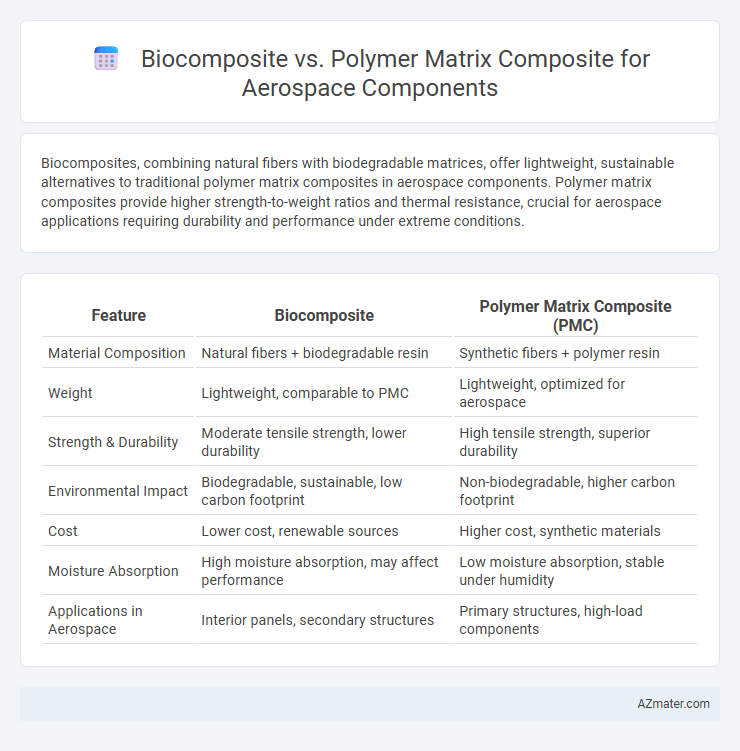Biocomposites, combining natural fibers with biodegradable matrices, offer lightweight, sustainable alternatives to traditional polymer matrix composites in aerospace components. Polymer matrix composites provide higher strength-to-weight ratios and thermal resistance, crucial for aerospace applications requiring durability and performance under extreme conditions.
Table of Comparison
| Feature | Biocomposite | Polymer Matrix Composite (PMC) |
|---|---|---|
| Material Composition | Natural fibers + biodegradable resin | Synthetic fibers + polymer resin |
| Weight | Lightweight, comparable to PMC | Lightweight, optimized for aerospace |
| Strength & Durability | Moderate tensile strength, lower durability | High tensile strength, superior durability |
| Environmental Impact | Biodegradable, sustainable, low carbon footprint | Non-biodegradable, higher carbon footprint |
| Cost | Lower cost, renewable sources | Higher cost, synthetic materials |
| Moisture Absorption | High moisture absorption, may affect performance | Low moisture absorption, stable under humidity |
| Applications in Aerospace | Interior panels, secondary structures | Primary structures, high-load components |
Introduction to Aerospace Composite Materials
Aerospace composite materials primarily consist of biocomposites and polymer matrix composites, each offering unique advantages in weight reduction and mechanical performance. Polymer matrix composites, typically reinforced with carbon or glass fibers, provide exceptional strength-to-weight ratios and thermal stability essential for high-performance aerospace components. Biocomposites, incorporating natural fibers with polymer matrices, present sustainable alternatives with potential for reducing environmental impact while maintaining adequate mechanical properties for non-critical aerospace applications.
Defining Biocomposites in Aerospace Applications
Biocomposites in aerospace applications are materials composed of natural fibers combined with polymer matrices, offering enhanced sustainability and reduced environmental impact compared to traditional polymer matrix composites. These biocomposites provide comparable mechanical properties such as high strength-to-weight ratio and corrosion resistance, essential for aerospace components. Their incorporation promotes lightweight design while addressing aerospace industry's increasing demand for eco-friendly alternatives without compromising performance and durability.
Overview of Polymer Matrix Composites
Polymer Matrix Composites (PMCs) consist of a polymer resin reinforced with fibers such as carbon, glass, or aramid, offering high strength-to-weight ratios crucial for aerospace components. These composites provide excellent fatigue resistance, corrosion resistance, and design flexibility compared to traditional metals. PMCs dominate aerospace applications due to their superior mechanical properties, thermal stability, and ability to be tailored for specific performance requirements.
Mechanical Properties Comparison
Biocomposites, incorporating natural fibers like flax or hemp, offer lower density and enhanced sustainability compared to traditional polymer matrix composites (PMCs), which typically use carbon or glass fibers for superior mechanical strength and stiffness. While PMCs demonstrate higher tensile strength (ranging from 600 to 1500 MPa) and improved fatigue resistance essential for aerospace structural components, biocomposites provide adequate impact absorption and vibration damping with tensile strengths generally between 100 and 300 MPa. The choice between biocomposites and PMCs in aerospace applications depends largely on specific performance requirements, balancing mechanical durability against weight reduction and environmental impact.
Weight and Density Considerations
Biocomposites typically exhibit lower density compared to traditional polymer matrix composites, making them advantageous for aerospace components where weight reduction is critical. The reduction in weight can improve fuel efficiency and payload capacity without compromising structural integrity. However, polymer matrix composites often provide higher strength-to-weight ratios, requiring careful material selection based on specific aerospace performance requirements.
Environmental Impact and Sustainability
Biocomposites, composed of natural fibers and biodegradable resins, significantly reduce carbon footprint and waste generation compared to traditional polymer matrix composites used in aerospace components. Polymer matrix composites, typically derived from non-renewable petroleum resources, present challenges in recycling and contribute to long-term environmental pollution. The superior sustainability profile of biocomposites supports aerospace industry goals of minimizing ecological impact while maintaining necessary performance standards.
Thermal Stability and Performance
Biocomposites exhibit lower thermal stability compared to polymer matrix composites (PMCs) due to the inherent decomposition of natural fibers at elevated temperatures, limiting their use in high-temperature aerospace applications. PMCs, especially those reinforced with carbon or glass fibers, offer superior thermal resistance and maintain mechanical performance under extreme thermal cycles typical in aerospace environments. The enhanced thermal stability of PMCs ensures reliability and durability in critical components exposed to fluctuating thermal stresses during flight.
Cost Analysis and Manufacturing Processes
Biocomposites offer a cost-effective alternative to polymer matrix composites (PMCs) in aerospace components due to lower raw material costs and reduced environmental impact, although PMCs provide superior mechanical properties and higher thermal resistance. Manufacturing processes for biocomposites typically involve simpler, energy-efficient techniques such as compression molding and extrusion, contrasting with the more complex and resource-intensive methods like autoclave curing used for PMCs. Cost analysis reveals that biocomposites reduce overall production expenses by minimizing energy consumption and utilizing renewable materials, but PMCs still dominate applications demanding high strength-to-weight ratios and durability.
Current Aerospace Industry Trends
Biocomposites are gaining traction in the aerospace industry due to their lightweight, sustainable properties and reduced environmental impact compared to traditional polymer matrix composites (PMCs). Current trends highlight the integration of natural fibers and bio-based resins in biocomposites, aiming to meet stringent aerospace performance standards while enhancing recyclability and reducing carbon footprint. However, PMCs remain dominant for high-strength, high-temperature applications, driving ongoing research to improve biocomposite durability and resistance for broader aerospace adoption.
Future Prospects for Biocomposites and PMCs in Aerospace
Biocomposites exhibit increasing potential in aerospace due to their lightweight, sustainable nature, and improved mechanical properties derived from natural fibers like flax and hemp, offering enhanced environmental benefits over traditional Polymer Matrix Composites (PMCs). Future advancements in biocomposite resin systems and fiber treatments are expected to improve durability and thermal stability, making them more competitive with PMCs in high-performance aerospace applications. PMCs continue to dominate aerospace component manufacturing due to superior strength-to-weight ratios and proven performance, but integrating biocomposite elements presents a promising path toward reducing carbon footprints in next-generation aerospace materials.

Infographic: Biocomposite vs Polymer Matrix Composite for Aerospace Component
 azmater.com
azmater.com